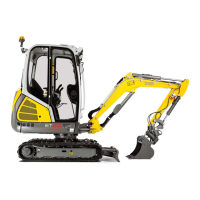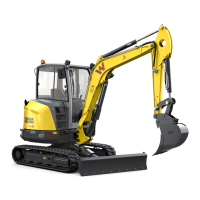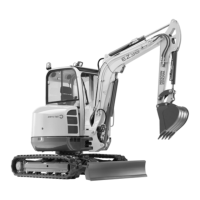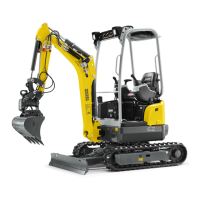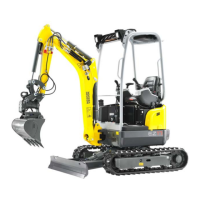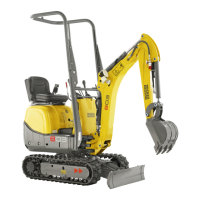OM ET18/20/24 us 1.3 * Sicherheit(us).fm 2-9
• Check the machine before entering the cab to operate the machine for
visible damage and defects. Report any changes, including changes in
the machine’s function and response, to your supervisor immediately!
• If the machine is functioning unpredictably, stop the machine immedi-
ately, lock it, and report the malfunction to a qualified tecnician or
supervisor. Safety-relevant damage or malfunctions of the machine
must be rectified immediately.
Traveling
• When traveling on or in public areas, observe all applicable regula-
tions. Make sure beforehand that the machine is in compliance with
these regulations.
• Installed work lights must NOT be used for travel.
• When crossing underpasses, gates, bridges and tunnels, or when
passing under overhead lines, make sure the clearance height and
width are sufficient to avoid contact.
• Empty the bucket before traveling on public roads.
2.7 Applications with Lifting Gear
General information
• Craning applications are procedures involving raising, transporting and
lowering loads with the help of slings and load-securing devices (for
example, ropes and tracks). In doing so, the help of persons is
necessary for securing and detaching the load. This applies, for
example, to lifting and lowering pipes, shaft rings or containers.
• The excavator may be used for applications with lifting gear ONLY if
the prescribed safety devices are in place and functional.
Safety criteria
• When used for craning applications, the machine must meet the
following criteria:
- Proper equipment for slinging and securing the load
- Proper lift capacity per tables in this Operator’s Manual
• In addition, a safe load indicator is required for machines bearing loads
of over 1000 kg (2,205 lbs.) or an overturning moment of over 40000
Nm (29,477 ft.lbs.).
Conditions for safe operation
• Secure the load to prevent it from falling or slipping. Install an OSHA-
approved load hook after removing the bucket or other approved
attachment to provide a secure attachment point for the lifting sling,
track, or cable.
• Have loads fastened, and crane operators instructed, by a qualified
person competent in raning operation and standard hand signals. The
person giving instructions to the operator must be within sight of the
operator during load attachment and load disconnection.
• The load shall be kept as close to the surface as practical to accom-
plish the craning operation. The operator shall gently move the controls
and machine to avoid swing or oscillating motion of the load. A tether
line is recommended to dampen the tendency of the load to swing or
oscillate during the craning operation.

